Most read articles by the same author(s)
- Emma Suri Yanti Siregar, Vincentius Paulus Siregar, Syamsul Bahri Agus, ANALISIS DAERAH PENANGKAPAN IKAN TUNA SIRIP KUNING Thunnus albacares DI PERAIRAN SUMATERA BARAT BERDASARKAN MODEL GAM , Jurnal Ilmu dan Teknologi Kelautan Tropis: Vol. 10 No. 2 (2018): Jurnal Ilmu dan Teknologi Kelautan Tropis
- Nico Wantona Prabowo, Vincentius P. Siregar, Syamsul Bahri Agus, KLASIFIKASI HABITAT BENTIK BERBASIS OBJEK DENGAN ALGORITMA SUPPORT VECTOR MACHINES DAN DECISION TREE MENGGUNAKAN CITRA MULTISPEKTRAL SPOT-7 DI PULAU HARAPAN DAN PULAU KELAPA , Jurnal Ilmu dan Teknologi Kelautan Tropis: Vol. 10 No. 1 (2018): Jurnal Ilmu dan Teknologi Kelautan Tropis
- Noveldesra Suhery, Ario Damar, Hefni Effendi, CORAL REEF ECOSYSTEM VULNERABILITY INDEX TO OIL SPILL: CASE OF PRAMUKA ISLAND AND BELANDA ISLAND IN SERIBU ISLANDS , Jurnal Ilmu dan Teknologi Kelautan Tropis: Vol. 9 No. 1 (2017): Elektronik Jurnal Ilmu dan Teknologi Kelautan Tropis
- Mutiara Alkayakni Harahap, Vincentius Paulus Siregar, Syamsul Bahri Agus, SPATIAL AND TEMPORAL PATTERN OF PELAGIC FISHING GROUND USED OCEANOGRAPHY DATA IN WEST-SUMATERA WATERS , Jurnal Ilmu dan Teknologi Kelautan Tropis: Vol. 11 No. 2 (2019): Jurnal Ilmu dan Teknologi Kelautan Tropis






